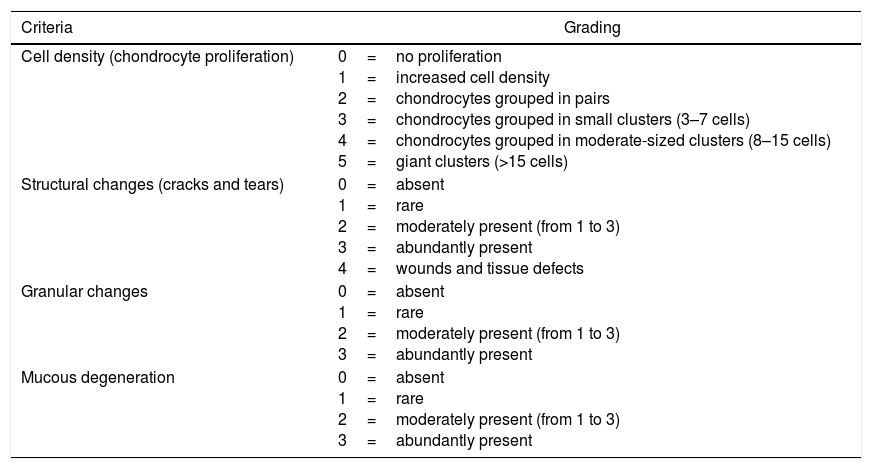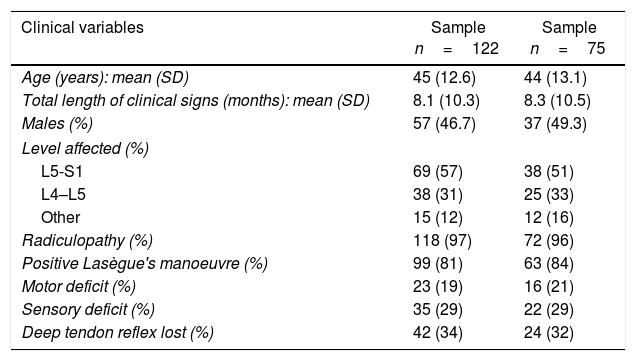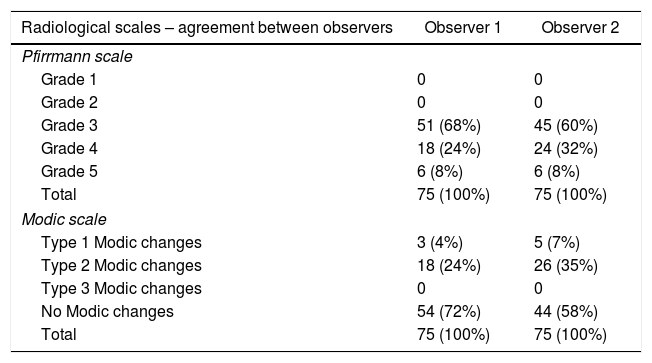The use of histological degeneration scores in surgically-treated herniated lumbar discs is not common in clinical practice and its use has been primarily restricted to research. The objective of this study is to evaluate if there is an association between a higher grade of histological degeneration when compared with clinical or radiological parameters.
Patients and methodRetrospective consecutive analysis of 122 patients who underwent single-segment lumbar disc herniation surgery. Clinical information was available on all patients, while the histological study and preoperative magnetic resonance imaging were also retrieved for 75 patients. Clinical variables included age, duration of symptoms, neurological deficits, or affected deep tendon reflex. The preoperative magnetic resonance imaging was evaluated using Modic and Pfirrmann scores for the affected segment by 2 independent observers. Histological degeneration was evaluated using Weiler's score; the presence of inflammatory infiltrates and neovascularization, not included in the score, were also studied. Correlation and chi-square tests were used to assess the association between histological variables and clinical or radiological variables. Interobserver agreement was also evaluated for the MRI variables using weighted kappa.
ResultsNo statistically significant correlation was found between histological variables (histological degeneration score, inflammatory infiltrates or neovascularization) and clinical or radiological variables. Interobserver agreement for radiological scores resulted in a kappa of 0.79 for the Pfirrmann scale and 0.65 for the Modic scale, both statistically significant.
ConclusionsIn our series of patients, we could not demonstrate any correlation between the degree of histological degeneration or the presence of inflammatory infiltrates when compared with radiological degeneration scales or clinical variables such as the patient's age or duration of symptoms.
El uso de escalas de degeneración histológica de las hernias discales lumbares intervenidas quirúrgicamente es poco frecuente en la práctica clínica y su empleo se ha limitado fundamentalmente al ámbito de la investigación. El objetivo del trabajo es valorar si existe relación entre un mayor grado de degeneración histológica cuando se compara con variables clínicas o escalas radiológicas.
Pacientes y métodoAnálisis retrospectivo de 122 pacientes consecutivos intervenidos por hernia discal lumbar monosegmentaria, de todos los cuales se dispone de información clínica y en 75 pacientes además se ha recuperado el estudio histológico y la resonancia magnética prequirúrgica. Las variables clínicas recogidas incluyen la edad, el tiempo de evolución de la sintomatología, el déficit neurológico o el reflejo osteotendinoso afectado. La resonancia magnética ha sido evaluada utilizando las escalas de Pfirrmann y Modic para el segmento intervenido por 2 observadores independientes. La degeneración histológica se ha evaluado utilizando la escala de Weiler; además se ha estudiado la presencia de infiltrados inflamatorios y la formación de neovasos, no incluidos en esta escala. Se han utilizado pruebas de correlación y de chi-cuadrado para valorar la asociación entre las variables histológicas y las clínicas o radiológicas. Se ha evaluado también la concordancia entre observadores en las variables de resonancia magnética mediante el índice kappa ponderado.
ResultadosNo se ha hallado ninguna relación estadísticamente significativa entre las variables histológicas (puntuación de la escala de degeneración discal, infiltrados inflamatorios, presencia de vasos neoformados) y las variables clínicas o las escalas radiológicas. La concordancia entre los 2 observadores para las escalas radiológicas resultó en un kappa de 0,79 para la escala de Pfirrmann, y de 0,65 para la de Modic, ambas estadísticamente significativas.
ConclusionesEn nuestra serie de pacientes no parece existir una relación entre el grado de degeneración histológica o la presencia de infiltrados inflamatorios cuando se evalúa su relación con escalas radiológicas de degeneración discal o con variables clínicas como la edad o el tiempo de evolución de los síntomas.
Article

If it is the first time you have accessed you can obtain your credentials by contacting Elsevier Spain in suscripciones@elsevier.com or by calling our Customer Service at902 88 87 40 if you are calling from Spain or at +34 932 418 800 (from 9 to 18h., GMT + 1) if you are calling outside of Spain.
If you already have your login data, please click here .
If you have forgotten your password you can you can recover it by clicking here and selecting the option ¿I have forgotten my password¿.















